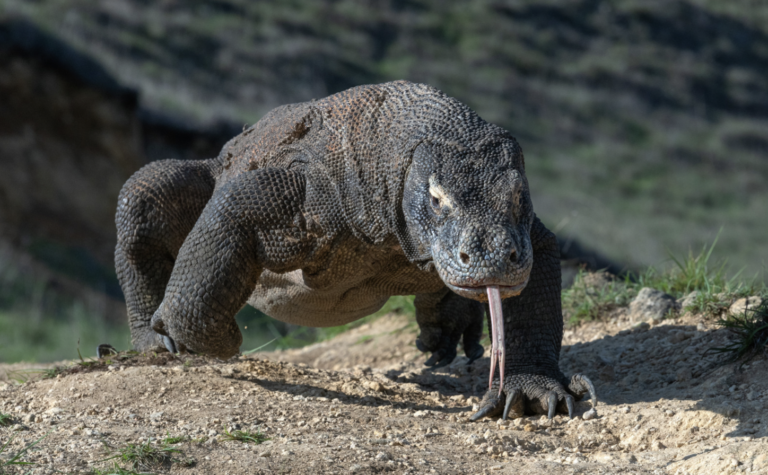Species in Peril:
KOMODO DRAGON

The biggest lizard on the planet
These Cats are Fast!
The Komodo dragon or as locally known as Ora in its natural habitat on the island of Komodo in Indonesia. Komodo dragons are about 2.5 meters long and weigh 45 kilograms. They rely on sneakiness and a speed of 20 kilometers per hour to hunt. They usually prey on deep, boar, goat, or any animal of similar size. They have a powerful vision as they can see objects from 300 meters away, and their eyes detect movement very easily.
Komodo dragons are thought to be deaf but now we know that they can hear noise within small ranges which helps them with hunting. Their limited hearing is due to having a single bone in their inner ear. Komodo dragon hearing is the most advanced among all lizards, but it is less powerful than hearing in mammals. The Komodo dragon’s sense of smell is essential for food detection. They smell by their long tongue samples the air and the two tips of the tongue retreated to the roof of the mouth. They also move their head from left to right to gather a bigger sense of their surroundings.
They can sense odors from four kilometers away. Their quick movement sounds like a muffled machine gun and their attack is bold and bloody as they quarry the prey on the ground and tear it to pieces. They have strong claws and teeth that make their attacks on their prey more successful. Komodo dragon’s jaws and throats help them to swallow huge chunks of their prey, and they have expanding stomachs which allow them to consume about 80% of their weight.
An aggressive lizard
Komodos are an aggressive lizard Large Komodos can attacks younger ones, and because of this, the young Komodos tend to roll in feces that can give a scent that they are bigger individuals. Komodo dragons can also attack humans, and it was reported that 24 human deaths were caused by Komodos. Komodo dragons are dangerous because of their speed, deadly bite, and venom. Their venom makes their preys bleed to death as it causes lower blood pressure, prevents clotting, and induces shock.
Male Komodos wrestle for mating, they use their tail for support and grab each other with their forelegs to throw their opponent to the ground. Mating usually occurs between May and August. Females lay eggs in September, but Komodos do not look after their newly hatched dragons. The hatchlings weigh less than 100 grams and are only 40 centimeters in length. They prey on small prey at early stages like insects, small lizards, snakes, and birds, until they mature. Komodo dragons can live up to 30 years.
In Danger of Extinction
Komodo dragons have a restricted home range that is considered to be the smallest of any large predator. The west discovered the Komodo dragon in 1910 and it was recognized to be rare at an early stage when protection plans were initiated in 1915. Nowadays, there are fewer than 1,500 mature dragons in Indonesia. Therefore, Komodo dragons consider to be endangered and are under the Convention on International Trade in Endangered Species of Wild Fauna and Flora.
The decline in Komodo’s number can be because of poaching of their primary prey like deer. Even though there are policies against this, the rugged and sometimes inaccessible habitat makes it difficult to monitor poaching. Another threat to the Komodo dragon is habitat loss and its major drivers in the area are subsistence farming, altered fire regimes, and deforestation that continues with a rate of 1% per year. Ecotourism has a limited effect on Komodos with no decline in the population of dragons where this activity most extensive over the past 50 years.
There are also some potential future threats to the population of Komodo dragons such as invasive species. The invasive Asian Common Toad has been known to affect monitor lizards that prey on invasive species; thus it could cause an impact on Komodos in the future. Moreover, climate change can cause a drastic effect on Komodo dragons as the majority of Komodos are residential in a limited area, thus any change in temperature, precipitation, and sea-level rise would influence most of the population.
A Few More Facts About Komodo Dragons
- Komodo dragons have long, flat heads with rounded snouts, scaly skin, bowed legs, and huge, muscular tails.
- Komodos dragons are athletic reptiles that can walk up to seven miles per day.
- Komodo dragons have 60 razor-sharp teeth up to one inch long and they go through four or five sets of teeth in their lifetime. Komodo preys get a bacterial infection when bitten as these bacteria are resident in the teeth of komodos.
- Some female Komodos can lay eggs asexually which is an evolutionary advantage, but it can cause inbreeding. Komodos babies are called hatchlings and only 1% of hatchlings survive to adulthood.
- Juvenile Komodos spend much of their time in trees to avoid being eaten by larger Komodos.
- Main conservation area for Komodo dragons is the Komodo National Park established in 1980 which is also a UNESCO World Heritage site.
Species Name
Varanus komodoensis
Estimated Population
1383 globally
Conservation Status
Endangered
Range
Indonesia
Reasons for Population Decline
Habitat destruction
Invasive species
Hunting and Poaching
Climate change


